 |
Home | Charity | Feedback |
France:
Annecy,
Chamonix Mont Blanc,
Paris,
Versailles
Versailles, France: Once, the seat of power by Prakash Bang, Editor in Chief 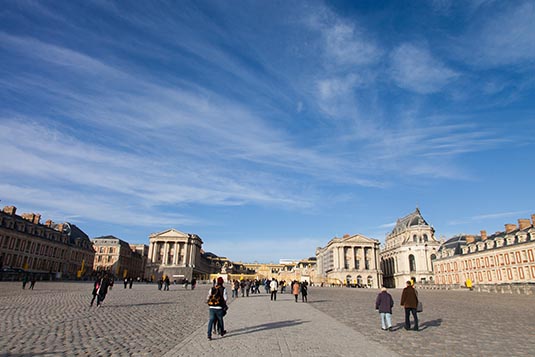 The town of Versailles was built around the Chateau (Palace). The Chateau de Versailles is one of the most beautiful achievements of 18th-century French art. The site began as Louis XIII’s hunting lodge before his son Louis XIV transformed and expanded it, moving the court and government of France to Versailles in 1682. Each of the three French kings who lived there until the French Revolution added improvements to make the palace more beautiful. 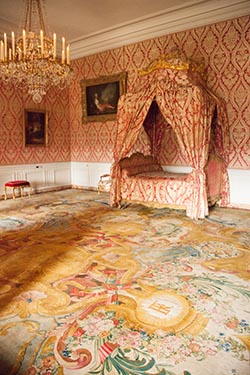 If you plan to be in Paris, do keep aside a day to visit Versailles. And let that day not be a Monday, since the Palace has its weekly off. SNCF trains depart at regular intervals from Gare Montparnasse. A return ticket costs EUR 6.50. In about 40 minutes you would be at Gare de Versailles Chantiers train station. The palace is a good 20-minute walk from the station. Buses are also available. I chose to walk as the journey itself unfolds many local nuances – churches, town houses, old squares and streets. It was 10AM when I arrived at Versailles Chantiers station.
If you plan to be in Paris, do keep aside a day to visit Versailles. And let that day not be a Monday, since the Palace has its weekly off. SNCF trains depart at regular intervals from Gare Montparnasse. A return ticket costs EUR 6.50. In about 40 minutes you would be at Gare de Versailles Chantiers train station. The palace is a good 20-minute walk from the station. Buses are also available. I chose to walk as the journey itself unfolds many local nuances – churches, town houses, old squares and streets. It was 10AM when I arrived at Versailles Chantiers station.
There’s also a RER train that drops you directly in front of the palace. The station is Gare de Versailles Rive Gauche. However, on the day of my visit the trains to that station were off. That’s the reason why I had to choose the SNCF. It was a blessing in disguise though. The walk along Rue Des Chantiers and then along Avenue De Paris was quite rewarding. By 10:30 I was at the palace gates. The Chateau de Versailles, the seat of power until 1789, has continued to unfurl its splendour over the course of centuries. At first it was just a humble hunting lodge built by Louis XIII. But Louis XIV chose the site to build the palace we see today - the symbol of royal absolutism and embodiment of classical French art. 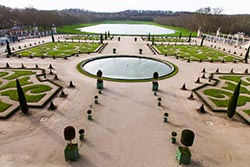 Visitors have the option to buying tickets based on their interest. I would suggest buying a ‘passport’ that allows access to all that the palace has to offer – Gardens; the Chateau; the Chateaux de Trianon and the Estate of Marie-Antoinette and the temporary exhibitions.
Visitors have the option to buying tickets based on their interest. I would suggest buying a ‘passport’ that allows access to all that the palace has to offer – Gardens; the Chateau; the Chateaux de Trianon and the Estate of Marie-Antoinette and the temporary exhibitions.
At the time of my visit the exhibition named Versailles and Antiquity was on. This exhibition explored all the relations between Antiquity and Versailles, the new Rome built to proclaim the glory of the Sun King who identified himself with the figure of Apollo. In the 1670s Louis XIV built the Grand Apartments of the King and Queen. The most emblematic achievement is the Hall of Mirrors designed by Mansart, where the king put on his most ostentatious display of royal power in order to impress visitors. The Chapel and Opera were built in the next century under Louis XV. 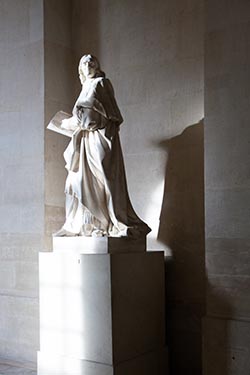 The chateau lost its standing as the official seat of power in 1789 but acquired a new role in the 19th century as the Museum of the History of France, which was founded at the behest of Louis Philippe, who ascended to the throne in 1830. That is when many of the chateau’s rooms were taken over to house the new collections, which were added to until the early 20th century, tracing milestones in French history.
The chateau lost its standing as the official seat of power in 1789 but acquired a new role in the 19th century as the Museum of the History of France, which was founded at the behest of Louis Philippe, who ascended to the throne in 1830. That is when many of the chateau’s rooms were taken over to house the new collections, which were added to until the early 20th century, tracing milestones in French history.
In 1661, Louis XIV commissioned Andre Le Notre with the design and laying out of the gardens of Versailles which, in his view, were just as important as the Chateau. From the central window of the Hall of Mirrors the visitor look down on the grand perspective that leads the gaze from the Water Parterre to the horizon. This original perspective, which preceded the reign of Louis XIV, was developed and prolonged by the gardener Andre Le Notre by widening the Royal Path and digging the Grand Canal. This vast perspective stretches from the facade of the Chateau de Versailles to the railings of the park. In 1687 Jules Hardouin Mansart built the Grand Trianon, probably the most refined group of buildings in the domain of Versailles, on the site of the “Porcelain Trianon”, which Louis XIV had had erected in 1670 to escape the pomp and rigid formality of court life with his mistress Madame de Montespan. 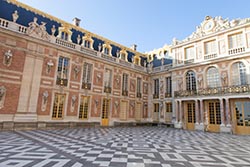 Italian architecture heavily influenced the architecture of the building, which stands between a courtyard and garden. A balustrade once graced with vases, statues of groups of children and sculpted figures conceals the flat roof.
Italian architecture heavily influenced the architecture of the building, which stands between a courtyard and garden. A balustrade once graced with vases, statues of groups of children and sculpted figures conceals the flat roof.
Louis XIV occupied the Grand Trianon, where he also housed his sister-in-law the Princess Palatine, his son-in-law the Duc de Chartres and his daughter the duchesse de Bourbon. Napoleon Bonaparte had the palace restored before staying here on many occasions with his second wife, Empress Marie Louise. In 1963 Charles de Gaulle had it restored as a guesthouse for presidents of France and the northern wing, known as “Trianon Sous Bois”, was converted into an official presidential residence. 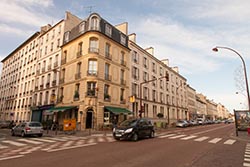 From the Petit Trianon to the Queen’s Gardens, passing by the Hamlet, the Estate, opened in 2006, reveals Marie-Antoinette’s private life. Louis XVI’s wife loved this place where she could return to the pleasures of simple, rural pursuits, away from the pomp of Versailles. The Petit Trianon and its park are certainly linked to the memory of Queen Marie-Antoinette. She is the only queen to have imposed her personal taste on Versailles.
From the Petit Trianon to the Queen’s Gardens, passing by the Hamlet, the Estate, opened in 2006, reveals Marie-Antoinette’s private life. Louis XVI’s wife loved this place where she could return to the pleasures of simple, rural pursuits, away from the pomp of Versailles. The Petit Trianon and its park are certainly linked to the memory of Queen Marie-Antoinette. She is the only queen to have imposed her personal taste on Versailles.
Sweeping away the old court and its traditions, she insisted on living as she wished. In her Trianon domain, which Louis XVI gave her in 1774, she found the heaven of privacy that enabled her to escape from the rigours of court etiquette. Nobody could come there without her invitation. Thankfully, these days you don’t need one. At 2 in the afternoon I turned back. Unexplored Paris was calling. Versailles Image Gallery  Photo viewer Photo viewer
|
|
|
Home |
Charity |
Feedback
Privacy Policy | Terms of Usage © YoGoYo.com. All rights reserved. |





















































